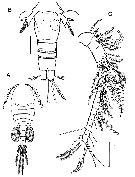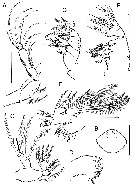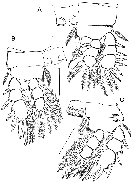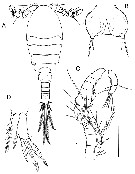|
|
 |
Fiche d'espèce de Copépode |
|
|
Cyclopoida ( Ordre ) |
|
|
|
Cyclopettidae ( Famille ) |
|
|
|
Paracyclopina ( Genre ) |
|
|
| |
Paracycloppina sacklerae Boxshall & Jaume, 2012 (F,M) | |
| | | | | | | Ref.: | | | Boxshall & Jaume, 2012 (p.37, Descr. F,M, figs.F,M) |  Issued from : G.A. Boxshall & D. Jaume in Zootaxa, 2012, 3150. [p.39, Fig.1]. Female (from 5°11.052'S, 122°35159'E): A: habitus ovigerous (dorsal); B, urosome (Ventral; with caudal seta omitted); C, A1. Scale bars: 100 mm (A); 50 µm (B, C). Nota: 1st pedigerous somite free, but partly concealed by posterior extension of dorsal cephalic shield. Epimeral angles of free 2nd to 4th pedigerous somites rounded. Rostrum rounded, well developed. Nauplius eye not observed. Ratio of prosome to urosome length (including caudal rami) about 1.5:1. Urosome 5-segmented, comprising 5th pedigerous somite, genital double-somite (formed by fusion of genital and 1st abdominal somites, and 3 free abdominal somites. Genital apparatus comprising paired copulatory pores located within dorsolateral gonopores: seminal receptacles paired. Egg sacs paired, with 7 to 9 eggs. Caudal rami about 1.3 times longer than wide and bearing 6 caudal setae (seta I absent). A1 17-segmented
|
 Issued from : G.A. Boxshall & D. Jaume in Zootaxa, 2012, 3150. [p.40, Fig.2]. Female: A, A2; B, labrum (ventral); C, Md (mandibular palp, with position of missing seta shown by arrow); D, Md (biting edge of mandibular gnathobase); E, Mx1; F, Mx2; G, Mxp. All scale bars = 50 µm. Nota: Labrum ovoid, with entire posterior margin; surface ornamentation of spinules on raised anterior zone. Mandible comprising coxa with well developed gnathobase bearing numerous blades along oblique margin. Endopod: 2-segmented with 3 + 5 setae. Exopod: 4-segmented bearing 5 sparsely plumose setae. Mx1 with large praecoxal arthrite bearing 8 marginal setal elements; coxal endite bearing single seta; coxal epipodite represented by long plumose seta; basis produced into 2 endites medially bearing 3 (proximal) and 2 (distal) spinulose setae; endopod comprising single expressed segment bearing 1, 1, 5 spinulose setae; exopod 1-segmented with 4 long plumose setae. Mx2: well developed, 5-segmented; praecoxa and coxa incompletely separated, bearing 4 inner margin endites, armed with 3, 1, 3, 2 spinulose setae (from proximal to distal); basis bearing powerful claw-like element and spinulose seta, ornamented with spinule rows; endopod 3-segmented, bearing 4, 1, 3 setal elements (from proximal to distal). Mxp: smaller than Mx2; 4-segmented; 1st segment (syncoxa) produced into 2 endites, proximal endite with 3 spinulose setae, distal endite armed with 2 setae, ornamented with row of spinules; 2nd segment (basis) with 2 spinulose setae and row of spinules; endopod 2-segmented, 1st endopodal segment with 2 unequal spinulose setae and 2nd endopodal segment with 4 spinulose setae.
|
 Issued from : G.A. Boxshall & D. Jaume in Zootaxa, 2012, 3150. [p.41, Fig.3]. Female: A, P1 (anterior); B, P2 (anterior); C, P4 (anterior). All scales = 50 µm.
|
 Issued from : G.A. Boxshall & D. Jaume in Zootaxa, 2012, 3150. [p.38]. Female & Male: Spine (Roman numerals) and seta (Arabic numerals) formula from swimming legs P1 to P4.
|
 Issued from : G.A. Boxshall & D. Jaume in Zootaxa, 2012, 3150. [p.42, Fig.4]. Male: A, habitus (dorsal); B, genital somite (ventral); C, A1, with 2 segments distal to geniculation shown disarticulated; D, P5 (ventral). Scale bars: 100 µm (A); 50 µm (B, C); 25 µm (D). Nota: Ratio of prosome to urosome length (including caudal rami) about 1.7:1. Epimeral angles of free 3rd pedigerous somites slightly produced. Urosome 6-segmented, comprising 5th pedigerous somite, genital somite and 4 free abdominal somites. Genital somite bearing paired genital openings ventrally. Caudal rami about 1.25 times longer than wide and bearing 6 caudal setae (seta I absent), relative lengths of setae as for female. A1 symmetrical, geniculate, 17-segmented. A2 to Mxp and legs 1 to 4, as in female. P5 as in female except free exopodal segment, about 2.4 times longer than wide, bearing lateral margin spine , outer distal spine, plumose apical seta and inner distal spine; inner margin of segment smooth.
| | | | | NZ: | 1 | | |
|
Carte de distribution de Paracycloppina sacklerae par zones géographiques
|
| | | | Loc: | | | Indonesia (Muna Island)
Type locality: 5°11.052' S, 122°35.159' E. | | | | N: | 1 | | | | Lg.: | | | (1177) F: 0,524-0,573; M: 0,408-0,461; {F: 0,524-0,573; M: 0,408-0,461} | | | | Rem.: | In sinkholes at Walengkabola village. | | | Dernière mise à jour : 19/07/2015 | |
|
|
 Toute utilisation de ce site pour une publication sera mentionnée avec la référence suivante : Toute utilisation de ce site pour une publication sera mentionnée avec la référence suivante :
Razouls C., Desreumaux N., Kouwenberg J. et de Bovée F., 2005-2025. - Biodiversité des Copépodes planctoniques marins (morphologie, répartition géographique et données biologiques). Sorbonne Université, CNRS. Disponible sur http://copepodes.obs-banyuls.fr [Accédé le 22 octobre 2025] © copyright 2005-2025 Sorbonne Université, CNRS
|
|
 |
 |







